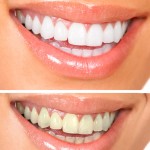
Tooth discolouration can be classified by its aetiology as either intrinsic or extrinsic. Extrinsic staining is a result of accumulation of chromatogenic substances from smoking, pigments in food and beverages. Intrinsic staining results from genetic disorders, caries, pulpal damage or filing materials as well as ageing. Bleaching can reduce extrinsic staining and intrinsic staining caused by some conditions. A wide range of whitening products using different application methods, concentrations of whitening agent and treatment duration are currently available.
The aim of this Cochrane review update was to assess the effects of home-based tooth whitening products with chemical bleaching action, dispensed by a dentist or over-the- counter.
Methods
Searches were conducted in the Cochrane Oral Health’s Trials Register, the Cochrane Central Register of Controlled Trials (CENTRAL) Medline, Embase, the US National Institutes of Health Ongoing Trials Register (ClinicalTrials.gov) and the World Health Organization International Clinical Trials Registry Platform with no restrictions on the language or date of publication.
Randomised controlled trials (RCTs) involving patients over the age of 18 comparing dentist-dispensed or over-the-counter tooth whitening (bleaching) products with placebo or other comparable products were considered. Quasi-randomised trials and those combining in-office and at home treatments as well as those involving physical removal of stains were excluded.
Study selection, data abstraction and risk of bias assessment was carried out independently by two review authors. Risk ratios (RR) were used for dichotomous data and standardised mean difference (SMD) for continuous data, with 95% confidence intervals (CIs). The certainty of the evidence was assessed using the GRADE approach.
Results
- 71 RCTs were included
- 26 studies (1398 patients) compared a bleaching agent to placebo
- 51 studies (2382 patients) compared a bleaching agent to another bleaching agent.
- 2 studies were considered to be at low risk of bias, 2 at high risk and 67 at unclear risk.
- The is low to very low certainty evidence that at different concentrations with varying application times bleaching agents (carbamide peroxide (CP) gel in tray, hydrogen peroxide (HP) gel in tray, HP strips, CP paint-on gel, HP paint- on gel, sodium hexametaphosphate (SHMP) chewing gum, sodium tripolyphosphate (STPP) chewing gum, and HP mouthwash)whitened teeth compared to placebo over a short time period (from 2 weeks to 6 months),
- The current evidence is insufficient draw reliable conclusions regarding the superiority of home-based bleaching agents or application methods, time or duration or concentration because of wide variation in these elements of the studies. In addition, most comparisons were reported in single trials with small sample sizes and event rates providing evidence of low or very low quality.
- Tooth sensitivity and oral irritation were the most common side effects which were more prevalent with higher concentrations of active agents though the effects were mild and transient.
- Tooth whitening did not have any effect on oral health-related quality of life.
Conclusions
The authors concluded: –
We found low to very low-certainty evidence over short time periods to support the effectiveness of home-based chemically-induced bleaching methods compared to placebo for all the outcomes tested.
We were unable to draw any conclusions regarding the superiority of home-based bleaching compositions or any particular method of application or concentration or application time or duration of use, as the overall evidence generated was of very low certainty. Well-planned RCTs need to be conducted by standardising methods of application, concentrations, application times, and duration of treatment.
Comments
This Cochrane review update adds 46 new studies to the previous version bringing the total up to 71 trials. However, as the authors highlight in the discussion most the available trials were small single study trials. These could not be meta-analysed because of the different methods of application, concentrations of bleaching agents, application times or duration of use. A majority of the studies also focus on short-term results. As a consequence, the evidence for home-based tooth whitening products is of very low certainty. Future studies need to be well designed with greater standardisation of methods and reporting outcomes including patient reported outcomes and cost-effectiveness.
Link
Primary Paper
Eachempati P, Kumbargere Nagraj S, Kiran Kumar Krishanappa S, Gupta P, Yaylali IE. Home‐based chemically‐induced whitening (bleaching) of teeth in adults. Cochrane Database of Systematic Reviews 2018, Issue 12. Art. No.: CD006202. DOI: 10.1002/14651858.CD006202.pub2.
Other references
Dental Elf – Tooth Whitening Blogs
